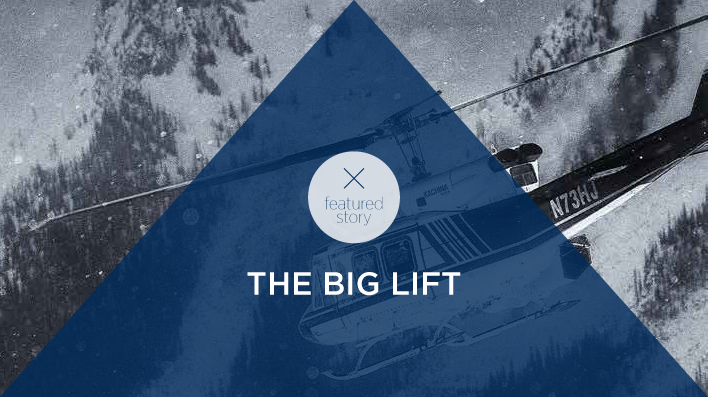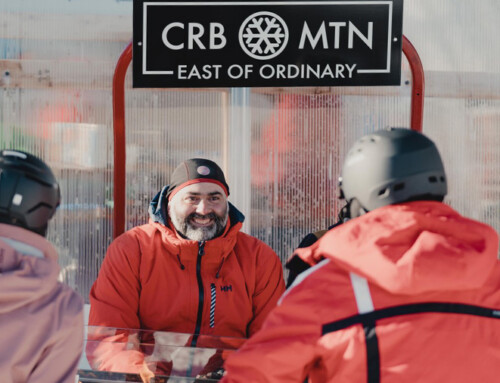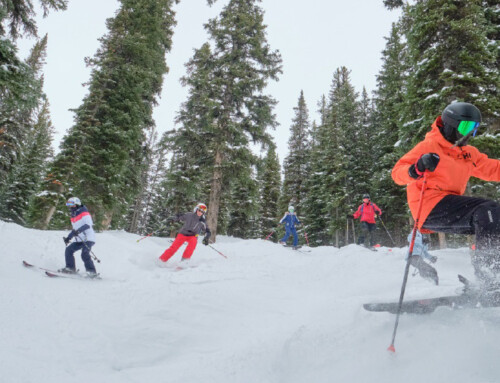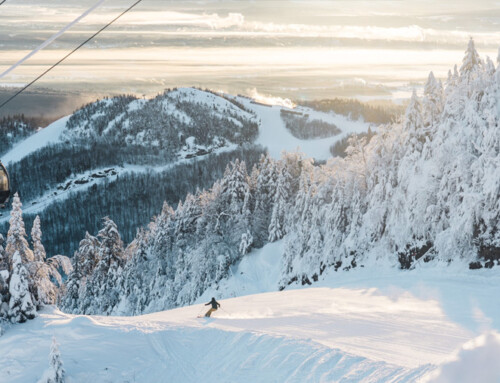
STORY: S-Media
BY: Lesley Anthony PHOTOGRAPHY: Paul Morrison
On a sunny day in a regular alpine forest, the familiar waistlines of healthy, snowbound conifers offer labyrinthine alleys that alternately open and close with every turn, eliciting skiing both careful and controlled. In a burn, however, where you can see far down a slope with little impediment by the blackened spires or shadows they set across the snow like so many sabers laid to rest, the arrangement invites wild, high-speed riding. It’s as if the life that went up in smoke left some kind of ghostly signature, an energy driving the kind of bravado that leaves charcoal streaks on your Gore-Tex. Careful and controlled it is not. Woo-hoo! Fun it most certainly is.
At the bottom of this particular run were the usual smiles and chatter, folks taking the piss in every direction, razzing each other’s skiing as well as the wealth of personality traits you learn to exploit after a week spent flying together. The Aussie-dominated mob that had adopted us were the friendliest, funniest people we’d met in a long time and we were now a dozen instant friends on a spectacular powder day. It felt like we were in a beer commercial (which, given the daily consumption soon to unfold at the lodge bar, we sort of were) but also privileged beyond belief to share this experience in such a beautiful environment—a fitting way to end a brilliant week at CMH Bugaboos, birthplace of heli-skiing and, a half-century on, still one of its most revered outposts.
Our first three days in “the bugs” had been bluebird inversions, cold in the valleys and warmer up top. Beautiful conditions for poking around in the air, which was good since it hadn’t snowed in many weeks the story of B.C.’s early winter in 2014. Thus we’d ranged far into the nether reaches of this vast tenure, variously skirting the edges of CMH’s neighbouring Bobbie Burns and Gothics tenures in the process. There’d been the usual handful of sketchy surprises—sun-baked surfaces, setup tracks, dust on crust, or places where wind-transported snow had hardened into knee-rattling striations—but for the most part the guides found us soft, beautiful powder up to 30 cm deep. Clear conditions had encouraged surface hoar, delivering amazing sounds of passage through the super-fast snow, like skiing on the pulverized remains of fine glass. There’d been some mighty fine runs but the best were those that dropped 1,200 metres from long, lolling glacial saddles to the valley: starting in eye-widening alpine—the kind of terrain you can’t believe you’re in and surely wouldn’t be if not for the chop- per—we’d tipped into wide-open expanses where you could ski at any speed you dared before angling down valley walls, aprons and ridges to end in the kind of snow-tree glades B.C. is famous for. To cap one such leg-numbing day, we’d been dropped in the magnificent amphitheater below the granite faces of Bugaboo, Snowpatch and Pigeon Spires. We skied close beneath Snowpatch, then down to a bench in what seemed a rarified feat of reverse mountaineering. Blue ice poked here and there from the glacier’s surface, and granite whale backs exposed by waning ice breached in testament to the combination of low snow and high wind that had characterized this winter.
The sunny days were nice, of course, but we all wanted snow. Trying to drink it grey around the fireplace in the spacious lodge with the over-enthusiastic Aussies wasn’t working, however, so midweek, staff arranged a bonfire in hopes of attracting the AWOL snow gods. Despite being dead tired after 14 runs and our daily après self-flagellation, followed by hot tub/sauna/steam/massage routines, a dinner of pork tenderloin (yet another in a series of heavenly meals), and copious wine, everyone rallied. Perhaps because, even if you didn’t believe people could make it snow, you felt the outcome required everyone’s energy and approval. Outside, we circled the fire until someone who’d been wearing a pair of underwear on their head tossed it on the pyre. Suddenly, both staff and guests disrobed one after another to offer their own inner layers. With everything from bras to boxers aflame and a fitting bottle of Fireball making the rounds, trans-global stories were told to a soundtrack of Led Zeppelin, Pink Floyd, and CSNY—classic rock for a classic crowd.
Miraculously, it started snowing, and by morning an encouraging 8cm sat at the lodge, which was understood to mean knee-deep in the places we would ski. Happily, it turned out to be true.
The energy around the well-stocked breakfast buffet was infectious, and several of us took advantage of the offer of even wider skis than the super-fats we’d been piloting from the well-stocked rental shop. The day was a blur of face shots and rooster tails, but I remember the that first drop, the unblemished slopes below shining with the possibility of thousands of giggle-inducing turns, and the surrounding peaks telling stories of deep time. That’s the thing about heli-skiing: every lift is a geology lesson—the sweep of the land, thrust of the mountains, glaciers, moraines, hanging valleys. Textbook stuff. Thus posed, every lift is also a revelation: of the forces that shape the earth, that keep it together, that populate its surface. And when you stand in skis on a summit in such a grand sweep of silence and history, it rings heavy in your ears and your heart, famously, grows two sizes. This was the moment that iconic guide and CMH founder Hans Gmoser knew so intimately, and dedicated his life to sharing with others.
Following on the 1950s helicopter experimentations of a few European and Alaskan skiers, Calgary geologist Art Patterson had convinced Banff-based Gmoser to guide for his nascent commercial heli-ski venture in 1963. Unfortunately, their two attempts were, by all measures, disastrous: costly, with manky snow and high winds that beat back the tiny, 178 horsepower, two seater Bell 47. Patterson gave up and Gmoser put the idea out of mind until, touring a ski movie through the eastern U.S., he met Olympic racer Brooks Dodge, an avowed powder-hound bullish on the potential of helicopters. What ensued was a classic partnership: a brash American with money and clients, and the circumspect Canadian mountain guide who knew his way around B.C.’s mountains. One place Gmoser didn’t know well was the Bugaboos, an unknown rock climbing area in a range known as the Purcells. That spring, he ski-toured in with a crack team and liked what he saw. With Dodge still keen on the big lift and Gmoser having found the perfect place to execute it, Dodge and his wife shepherded their New Hampshire ski club west in 1965 on a no-money-back adventure. The first heli- ski week in the range whose name would forever be synonymous with the activity delivered seven days of perfect pow and bluebird skies—a transcendent experience that launched an industry.
It couldn’t have happened in a more spectacular place. Lounging outside with the ribald Aussies in a steaming tub next to the biggest and best wood-fired sauna in the Rockies, the reveal of the Bugs when the clouds finally lifted was stupendous, close-enough to touch. It wasn’t just a proverbial million-dollar view, but a postcard paired with the history of ski mountaineering, climbing, and the heli-ski business. Historic on its own account, the lodge is also packed with iconography. Walls and hallways offer a photo history, while the Conrad Kain library comprises stacks of mountaineering volumes covering both the region and greater alpine world. A range of natural history items include rocks, minerals, and corings leftover from geology surveys; likewise tree cores (one spruce cored in 2013, a mere 61cm in diameter, proved 547 years old—a seedling in 1466, over 25 years before Columbus was the first European to vacation in the Caribbean) and a litany of skulls, bones, feathers and footprint casts. An ode to climbing/ski history comes in the form of antique pitons, ropes, crampons, packs, ice axes, a progression of powder skis, and even the Bolex movie camera that accompanied Gmoser to the summit of Denali—all of it arranged in glass-fronted cases very much like a museum. Given this homage, the ping-pong table centred in the room seems almost violate; on the other hand it encourages those who would play to marvel over these artifacts, the bricolage of a thousands legends.
The Bugs quickly make you aware of the so-called cult/club that CMH represents in the ski world. With many staff having worked at numerous CMH operations, however, the feel is more one of family—a large one with 11 lodges, 20 million square miles of tenure, and 9.5 million runs skied for some 18 billion vertical feet of powder bliss. One Texan on our week had just passed the 17,000,000-vertical-foot mark after 26 years skiing with CMH, and on our final night, another was honoured for achieving his 3,000,000th. He’d been so close to the milestone when everyone else quit for the day that staff flew him alone to a run above the lodge to log the last crucial feet. But he come up just short, and so before presenting him with his third million-foot CMH signature jacket, he’d had to make up the horizontal equivalent across the dining room on cross country skis. It got a good laugh.
Actually, everything got a good laugh that night as both tickle trunks and bar opened wide to fuel a ritual, week-ending costume ball that unfolded with the ridiculousness of a college fraternity. I awoke in the morning face down on my bed in a wig and a dress I’d apparently worn since dinner. I remember little of that, but can still recall with clarity every life-affirming run of the week.
In the end, tomfoolery makes it fun, familiar and ultimately human, but CMH is about delivering on one simple dream: the chance to enjoy perfect powder with friends in spectacular mountains. This ideal, which has existed since skiing’s beginning, is embodied in the epic joy of skiing powder, the camaraderie it forges, and the restorative power of mountains. CMH founder Hans Gmoser passionately conveyed these ideas as a mountain guide—whether evangelizing with clients or to movie audiences. When he eventually employed a helicopter to re-imagine skiing in the service of these ideas, it changed everything—and nothing. Fifty years later, that experience can still change your life.







